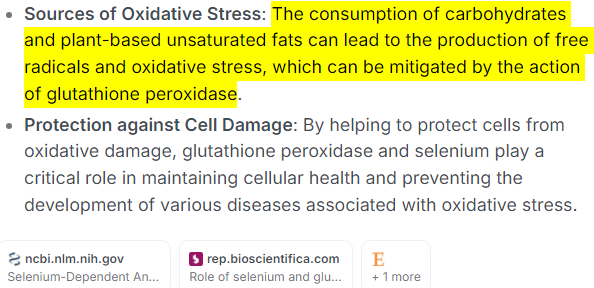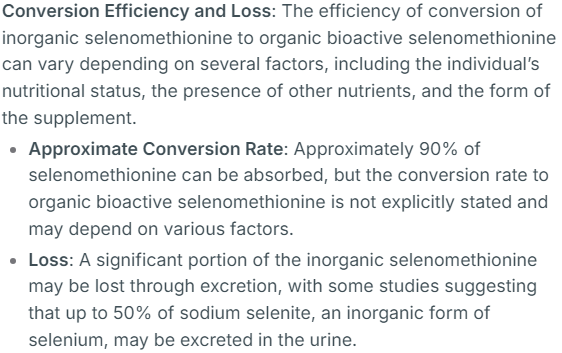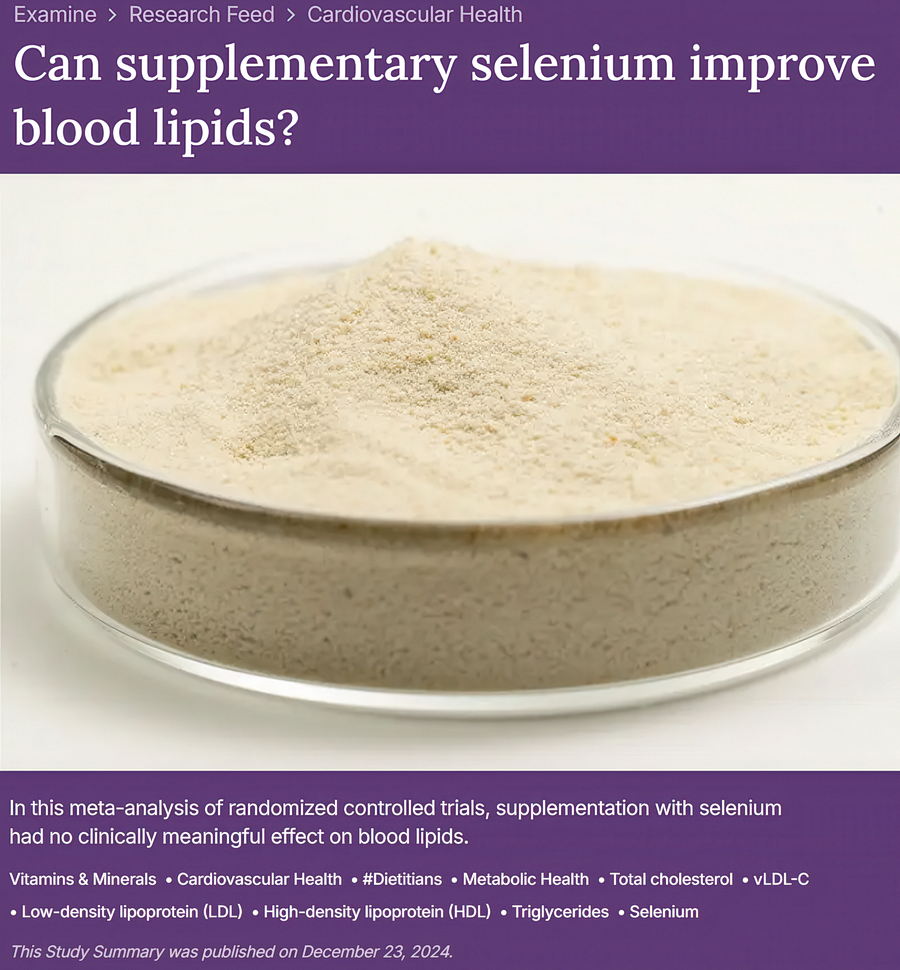Today we once again return to Examine.com and to a summary of a study on supplements as most people, including the staff at Examine, still fail to understand the most important aspect of any kind of supplement or compound from any kind of plant-based source. Yes, I’m talking about the chemical differences between an inorganic compound as found in plants or manufactured in a lab, and that of an organic bioactive compound as found in living tissue.

Most of the time, if it’s natural, as coming from the earth or from a plant, the body can convert a small part of it to an organic bioactive compound that it can use. However, this comes at a very high cost, as this “bioconversion” creates toxic residues from the conversion process that will cause harm to our body. But that is only one problem as whatever the body could not convert, which is usually much more than it could convert, is still present within the body and will also have very toxic properties, doing damage. And even worse, these inorganic compounds that have not been converted can attach themselves to tissues, causing toxic build-up, or even blockage, as for example seen with plant-based calcium and the antinutrient oxalate, as they form a crystal-like and sharp plaque in blood vessels, joints, and even as kidney stones. Actually, oxalate that binds to inorganic calcium is the most common cause for developing kidney stones, and thus is only possible by the consumption of plant-based garbage and/or supplements.





Now, supplements are always synthetic chemically derived fake copies of something they have identified. I Have explained this many times. The so-called supplementary “vitamins” are the worst offenders, as they have no resemblance to what is actually found in tissues or in animal-based foods. Minerals are much easier to identify and copy, however, they’re still inorganic and thus cause their own problems, as we recently discussed.

So, with this established and the undeniable fact that humans are obligate hyper carnivores, the only way to get any nutrient in a fully bioavailable and bioactive form without any toxic load is to get it from an animal that has already stored it in that exact form, just like we do. In other words, the only source of bioavailable, organic, and bioactive nutrients are from animal-based foods. This is basic level biology and biochemistry.



What was studied?
“The effect of supplementation with selenium on blood lipids (HDL cholesterol, LDL cholesterol, total cholesterol, vLDL cholesterol, and triglycerides).”
Well, while selenium is mostly known for its role in thyroid hormone metabolism, where it is needed for the conversion of T4 to T3, it is also said to be a key component of glutathione peroxidase, an enzyme that helps protect cells from damage caused by free radicals and oxidative stress. Also, it does play a role in our body’s healing processes, as it is needed by macrophages and T-lymphocytes.



However, this only means that if you’re very deficient in selenium, your healing capabilities may be compromised and slowed down, which then means that LDL will go down, as the healing process can’t utilize as much cholesterol as it should, which also temporarily could elevate HDL as unused cholesterol is transported back to the liver to be recycled or discarded.

If you’re not deficient, adding extra selenium above what the body needs, will do nothing. And if it’s inorganic selenium as in supplements or from plants, you will only increase the toxic load and the damage done to your body. Not very smart.
Who was studied?
“A total of 2,899 men and women (average ages of 21–67), including participants with no known health conditions, as well as participants with cardiovascular disease, central obesity, polycystic ovary syndrome, type 2 diabetes, gestational diabetes, diabetic nephropathy, chronic kidney disease, Alzheimer’s disease, or preeclampsia.”
People with no known health conditions should not notice any changes with increased selenium intake, unless they had a tiny bit of a deficiency, but still healthy enough to not notice any symptoms. And the rest of the people with one or more health conditions would probably not notice much either, as their health problems are all from a non-species appropriate diet of mostly plant-based slave garbage and processed crap. They likely have several nutrient deficiencies and also a very high toxic load. Simply adding in some selenium will not make a difference, and it will probably not even be noticed on the already extreme toxic load.
How was it studied?
“A meta-analysis of 25 randomized controlled trials was performed. The trials were conducted in Iran (19 trials), Denmark (2 trials), and 1 trial each in the Czech Republic, Finland, Germany, and the United Kingdom. In the vast majority of the trials, selenium yeast was used, in daily doses of 100–300 micrograms, and the comparator was a placebo. The intervention duration ranged from 4 weeks to 5 years.”
Supplemental selenium from yeast is manufactured through a process of fermentation, where yeast cells, typically Saccharomyces cerevisiae, are grown in an inorganic selenium-rich medium. The yeast cells are cultivated in a medium containing sodium selenite, which is a source of inorganic selenium. The yeast cells absorb the selenium from the medium and convert it into what researchers believe in an “organic form,” such as selenomethionine, through a process of bioaccumulation and biotransformation. The yeast cells are then harvested, washed, and dried to produce a selenium-enriched yeast biomass, which they use as a dietary supplement.


Selenium in the human body is mostly found in different “selenoproteins” which are involved in all the previously mentioned processes of selenium and is stored as “selenocysteine” in tissues (the structure found in all selenoproteins.) And since selenocysteine is the organic backbone of all selenoproteins in a living being, as in a human or animal, it cannot be chemically made in a lab or grown from yeast.
With that said, selenium is also found in small concentrations as “selenomethionine,” primarily in muscle tissue, similar to what the yeast produces. However, selenomethionine has very little involvement in selenoprotein synthesis and thus has a very low impact on the proclaimed functions of selenium.

So, even if your body can recognize and convert up to 90% selenomethionine in a selenium yeast supplement and convert it into the bioactive form of selenomethionine, its effect on selenoproteins is very low and thus its contribution to processes such as antioxidant defense, thyroid hormone metabolism, healing processes, or reproductive health is minimal at best. This is also displayed in studies that show that a lot of the ingested selenium is excreted in the urine.

In other words, even if you can absorb and convert the selenium yeast supplement, it will do pretty much nothing — but it will still pose a toxic threat to the body through bioconversion and non-converted compounds.
What were the results?
“Supplementation with selenium reduced (improved) vLDL cholesterol to a very small, potentially clinically insignificant, degree.
The risk of bias was low in 1 trial and unclear in 24 trials.”
You should not use the word “improved” if you do not know the health condition and the underlying problems causing it. VLDL (Very-Low-Density Lipoprotein) is a carrier of lipids in the body, similar to LDL. The main difference between VLDL and LDL is their composition. VLDL contains more triglycerides, while LDL contains more cholesterol. While cholesterol is needed by every single cell in the body and especially during tissue repair, triglycerides are mostly needed as energy for these processes while also regulating macrophages and neutrophils needed in healing.






And that is why both lipoproteins contain both cholesterol and triglycerides, but in various ratios. The cholesterol is the building block in the repair process, and the triglycerides provide the energy needed for that process of repairing the cell with the cholesterol. Our body knows what it is doing.

So, while triglycerides formed from consuming the wrong kind of food, as in carbohydrates and unsaturated fats to minimize direct damage, can cause a problem, triglycerides made by the body to assist in energy production and tissue repair are crucial for our health and should never be messed with.

So, in reality, the only way to know if your triglycerides are high due to tissue repair is to eliminate the sources of dietary triglycerides, as in eliminate the unnecessary and toxic carbohydrates and seed/vegetable oils and adopt our natural human carnivore diet.
Only when we follow our natural diet can our body work as intended, and our body is never wrong. If triglycerides and/or cholesterol is elevated when you are on a ketogenic carnivorous diet, then it’s simply because your body is healing, it’s repairing itself, and that is a very good and natural thing.
But as long as you consume the wrong kind of food, as in carbohydrates and unsaturated fats that can be converted to triglycerides, you do not know if high triglycerides are solely from food choices, from healing, or from both. And while it can be bad with really high levels of triglycerides, it can be even worse to lower triglycerides and thus slow down or even stop the healing, just as with cholesterol which is essential for healing.
So again, simply doing studies looking at one single compound and its possible effect on LDL, VLDL, HDL, cholesterol and triglycerides is futile. You should never try to lower these as they are needed by the body. If they’re dangerously high, it’s because of a shitty diet, so fix that diet and stop poisoning yourself with drugs, supplements and other crap in an idiotic attempt to lower something that you have no clue about in the first place.
And of course, don’t bother with selenium supplements as a “quick fix” to a deficiency unless you really know what you are doing. Always fix the diet first! Humans are obligate hyper carnivores, and if you do not eat like a carnivore, you are screwing yourself up, period.
If you need help with any kind of health problems or transitioning from your current way of eating to our natural species-appropriate, species-specific way of eating, I’m available for both coaching and consultation.
Coaching and Consultation
And if you found the article and my insights helpful and enjoy my daily free information, please consider donating to help pay the webhosting bills and keep the site running. And if you’re interested in discussing and sharing information with likeminded people, consider joining our uncensored community at Ungovernable.se. Thank you!

